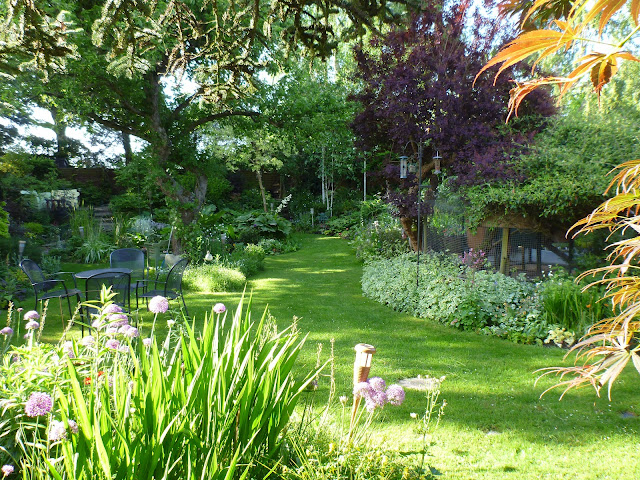 |
| Variegated hosta leaves. |
What is variegation?
Variegation just means that the leaves of a plant have more than one colour. Many hostas are variegated, but you probably don't think of them that way. If you are averse to variegated leaves then it is probably the more busy, spotty or multicoloured leaves that make you shy away.
 |
| A calming combination of a variegated hosta and fresh green ferns. |
 |
| A Marmite plant, you either love it or hate it, Persicaria Painter's Palette has incredible markings that are different on every leaf. |
Structural variegation is caused by light meeting the boundary between the outer layer of the leaf and a natural air-gap between the outer layer and the chlorophyll-containing cells beneath. The light is reflected and typically results in a silvery variegation. Most begonias and pulmonarias exhibit structural variegation.
 |
| Spotted leaves of Pulmonaria Wisley white. |
How to use variegated plants
Ok, so that was science bit, but how do you use variegated plants in your garden? It is generally best to avoid putting two variegated plants next to each other as they will compete for attention and look a bit too busy. But there is no reason why you can't dot variegated plants throughout a border, with plain-leaved plants in between. Pick out a colour from the variegated leaf and choose a companion plant with that leaf colour to place next to or near the variegated plant. The eye will be drawn from one to the other and the colour of both with be enhanced. It will generally work better if the companion plant has a different leaf shape and size.
Of course, there are always exceptions to the rules. I often place variegated hostas together. As their marking tend to be more definite rather than blotchy, they don't seem to fight with each other.
 |
| Variegated hostas around our little grove of birch trees. |
Grasses can add a calming effect to bold foliage, even if they are variegated themselves. As long as you blend different leaf shapes and sizes it is hard to go wrong - nature has a wonderful way of not causing a clash.
 |
| Even though both the carex and the hosta are variegated the difference in leaf shape results in a lovely combination. |
 |
| The very bright and bold foliage of a Solenostemon (coleus) is softened by the wispy foliage of Hakonechloa. The yellow veins of the grass pick out the yellow veining on the solenostemon. |
When you buy a new variegated plant try it in various locations before you plant it. Place the pot in the border and walk away. Look at the border from all angles to see what colours are picked out. You may have to try several places before you find the perfect spot. As the border develops you might change your mind, but you can always dig it up and move it!
 |
| Astrantia Sunningdale Variegated in the foreground with the red flushed foliage of Phlox paniculata Starfire on the left, and the dramatic bronze leaves of Rodgersia henrici on the right. |
So my advice it is to give it a go and experiment with some variegated foliage. One of the great joys of gardening is discovering new and exciting planting combination.
Also of interest in the garden at the moment -
 |
| It's too hard to choose one thing, it all looks so fresh and beautiful! |
Our to do list
Nematodes - Twice a year we water the potted plants with wine weevil nematodes. Wine weevil like to lay their eggs in pots and the white grubs can destroy the roots of a plant before you realise that there is something amiss. Nematodes are a natural treatment which seem to have been quite effective for us.
Planting out potted lilies - I plant single lily bulbs in plastic pots in autumn. I group them together in a sheltered place where I can easily check them for red lily beetle and remove them before they lay their eggs on the leaves. Once the lilies have got buds I plant them out in the garden. When they have finished flowering I dig them up and re-pot them in fresh compost ready for next year.
Getting ready for our charity open garden - We are opening our garden to celebrate 90 years of the National Garden Scheme on Monday 29th May, 1 till 5pm, so we want to make sure that everything looks its best. The alpine bed has been replanted (following some structural redesigning by a chicken last year) and the new Sarracenia (pitcher plant) bog at the edge of the pond had been completed, with a flower about to open for the first time! Half-hardy plants and annuals are being planted out. The finishing touch will be trimming the grass edges, which I do on my hands and knees with sewing scissors!


No comments:
Post a Comment